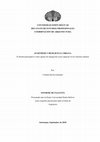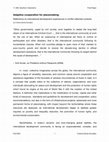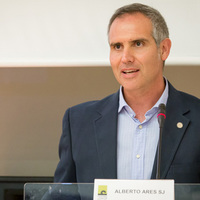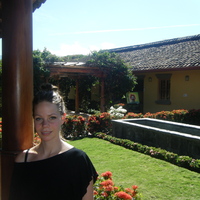Thesis Chapters by Cristina Davila Gonzalez

In -most- collective imaginaries across the globe, the international community depicts a figure o... more In -most- collective imaginaries across the globe, the international community depicts a figure of versatility, resources, and common values around cooperation translated into the mobilization of all kinds of resources. Nevertheless, in today's dynamic and ever-changing global realities, the international development community is facing an unprecedented set of challenges in performing their commitments to cooperation and assistance across hemispheres. For almost a century, the international development community has consolidated a network of nations, non-governmental organizations, multilateral organizations, and programs with an important presence and impact on life as we know it.
It has fostered spaces for reinvention but also tensions, as contrasting perspectives around the production of space and the deployment of aid in it have generated patterns of development partnerships based on financial dependency, and the overall compromise of a tool for autonomy that has paradoxically contributed, to an extent, to some of the conflict scenarios of today. Through the analysis and overview of three cases of study on international cooperation in conflict-affected areas across rural and urban latitudes in the Global South, this paper presents a series of guiding principles, features, and components of response programs and infrastructural projects to reflect on potential courses of innovative multilateral action.
This is the final paper for Gabriella Carolini's Fall 2022 seminar on Southern Urbanisms, enrolled as a cross-registered Harvard student at the Massachusetts Institute of Technology's Department of Urban Studies and Planning.

Proyecto Final de Grado, 2018
La resiliencia urbana se consolida cada vez más como un fundamento global de organización y gesti... more La resiliencia urbana se consolida cada vez más como un fundamento global de organización y gestión del futuro de la ciudades de hoy. Sin embargo, las formas de equilibrio urbano muchas veces se basan en la desigualdad, por lo que la resiliencia debe enmarcarse de manera holística para satisfacer las necesidades y aspiraciones de todos los agentes que conforman la ciudad.
Esta investigación se desarrolla en torno a la identificación del alcance del diseño participativo aplicado en procesos de planificación e integración socio-espacial como instrumento de resiliencia urbana en la ciudad, a partir la experiencia en el Programa de Prevención de Violencia a través del Mejoramiento Urbano (VPUU) en Ciudad del Cabo, Sudáfrica. Las experiencias de desarrollo urbano a través del diseño participativo indican que la resiliencia tiene lugar en la restauración física del ambiente construido, creación de redes socio- económicas e integración socio-espacial fundamentada en indicadores claves dentro de la definición de resiliencia urbana.
Books by Cristina Davila Gonzalez
by Metrolab Brussels, Mathieu Berger, louise carlier, Antoine Printz, joan Stavo-debauge, Sarah Van Hollebeke, Hélène Stryckman, Corentin Sanchez Trenado, Jonathan Orlek, Max Théréné, Cristina Davila Gonzalez, and Barbara Le Fort Mathieu Berger, Benoît Moritz, Louise Carlier, Marco Ranzato (Eds), Brussels, Metrolab Series, #1, 205 p., 2018
This book presents the productions of the first international MasterClass hosted by Metrolab in J... more This book presents the productions of the first international MasterClass hosted by Metrolab in January and February of 2017, on the topic of inclusion in urban spaces and urban projects. The event is the first stage of a larger project conducted at Metrolab and involving collective and collaborative research. We would like to begin with a word about this project that is dear to us.
Papers by Cristina Davila Gonzalez

In -most- collective imaginaries across the globe, the international community depicts a figure o... more In -most- collective imaginaries across the globe, the international community depicts a figure of versatility, resources, and common values around cooperation translated into the mobilization of all kinds of resources. Nevertheless, in today's dynamic and ever-changing global realities, the international development community is facing an unprecedented set of challenges in performing their commitments to cooperation and assistance across hemispheres. For almost a century, the international development community has consolidated a network of nations, non-governmental organizations, multilateral organizations, and programs with an important presence and impact on life as we know it.
It has fostered spaces for reinvention but also tensions, as contrasting perspectives around the production of space and the deployment of aid in it have generated patterns of development partnerships based on financial dependency, and the overall compromise of a tool for autonomy that has paradoxically contributed, to an extent, to some of the conflict scenarios of today. Through the analysis and overview of three cases of study on international cooperation in conflict-affected areas across rural and urban latitudes in the Global South, this paper presents a series of guiding principles, features, and components of response programs and infrastructural projects to reflect on potential courses of innovative multilateral action.
This is the final paper for Gabriella Carolini's course during the Fall 2022 Semester, on Southern Urbanisms, developed as a cross-registered student at the Massachusetts Institute of Technology's Department of Urban Studies and Planning.
China’s participation in the development visions of Latin America and the Caribbean has prolifera... more China’s participation in the development visions of Latin America and the Caribbean has proliferated over the past two decades with the consolidation of cooperation frameworks around soft and hard infrastructure across scales and thematics. In this context, the Belt and Road Initiative (BRI) does not represent a new policy but rather a rebranding of historical efforts based on a narrative of spatial, economic -and geopolitical- interconnectivity through trade and investment across the globe. This brief essay explores the way this foreign policy stance manifests in the context of Venezuela and former President Chávez 2006 National Socialist Plan for Railway Development.
This is a final paper for Marc Angelil's Spring 2022 course, Architectures of the New Silk Road: Spaces of Transnational Infrastructure-led Urbanism, at the Harvard University Graduate School of Design











Uploads
Thesis Chapters by Cristina Davila Gonzalez
It has fostered spaces for reinvention but also tensions, as contrasting perspectives around the production of space and the deployment of aid in it have generated patterns of development partnerships based on financial dependency, and the overall compromise of a tool for autonomy that has paradoxically contributed, to an extent, to some of the conflict scenarios of today. Through the analysis and overview of three cases of study on international cooperation in conflict-affected areas across rural and urban latitudes in the Global South, this paper presents a series of guiding principles, features, and components of response programs and infrastructural projects to reflect on potential courses of innovative multilateral action.
This is the final paper for Gabriella Carolini's Fall 2022 seminar on Southern Urbanisms, enrolled as a cross-registered Harvard student at the Massachusetts Institute of Technology's Department of Urban Studies and Planning.
Esta investigación se desarrolla en torno a la identificación del alcance del diseño participativo aplicado en procesos de planificación e integración socio-espacial como instrumento de resiliencia urbana en la ciudad, a partir la experiencia en el Programa de Prevención de Violencia a través del Mejoramiento Urbano (VPUU) en Ciudad del Cabo, Sudáfrica. Las experiencias de desarrollo urbano a través del diseño participativo indican que la resiliencia tiene lugar en la restauración física del ambiente construido, creación de redes socio- económicas e integración socio-espacial fundamentada en indicadores claves dentro de la definición de resiliencia urbana.
Books by Cristina Davila Gonzalez
Papers by Cristina Davila Gonzalez
It has fostered spaces for reinvention but also tensions, as contrasting perspectives around the production of space and the deployment of aid in it have generated patterns of development partnerships based on financial dependency, and the overall compromise of a tool for autonomy that has paradoxically contributed, to an extent, to some of the conflict scenarios of today. Through the analysis and overview of three cases of study on international cooperation in conflict-affected areas across rural and urban latitudes in the Global South, this paper presents a series of guiding principles, features, and components of response programs and infrastructural projects to reflect on potential courses of innovative multilateral action.
This is the final paper for Gabriella Carolini's course during the Fall 2022 Semester, on Southern Urbanisms, developed as a cross-registered student at the Massachusetts Institute of Technology's Department of Urban Studies and Planning.
This is a final paper for Marc Angelil's Spring 2022 course, Architectures of the New Silk Road: Spaces of Transnational Infrastructure-led Urbanism, at the Harvard University Graduate School of Design
It has fostered spaces for reinvention but also tensions, as contrasting perspectives around the production of space and the deployment of aid in it have generated patterns of development partnerships based on financial dependency, and the overall compromise of a tool for autonomy that has paradoxically contributed, to an extent, to some of the conflict scenarios of today. Through the analysis and overview of three cases of study on international cooperation in conflict-affected areas across rural and urban latitudes in the Global South, this paper presents a series of guiding principles, features, and components of response programs and infrastructural projects to reflect on potential courses of innovative multilateral action.
This is the final paper for Gabriella Carolini's Fall 2022 seminar on Southern Urbanisms, enrolled as a cross-registered Harvard student at the Massachusetts Institute of Technology's Department of Urban Studies and Planning.
Esta investigación se desarrolla en torno a la identificación del alcance del diseño participativo aplicado en procesos de planificación e integración socio-espacial como instrumento de resiliencia urbana en la ciudad, a partir la experiencia en el Programa de Prevención de Violencia a través del Mejoramiento Urbano (VPUU) en Ciudad del Cabo, Sudáfrica. Las experiencias de desarrollo urbano a través del diseño participativo indican que la resiliencia tiene lugar en la restauración física del ambiente construido, creación de redes socio- económicas e integración socio-espacial fundamentada en indicadores claves dentro de la definición de resiliencia urbana.
It has fostered spaces for reinvention but also tensions, as contrasting perspectives around the production of space and the deployment of aid in it have generated patterns of development partnerships based on financial dependency, and the overall compromise of a tool for autonomy that has paradoxically contributed, to an extent, to some of the conflict scenarios of today. Through the analysis and overview of three cases of study on international cooperation in conflict-affected areas across rural and urban latitudes in the Global South, this paper presents a series of guiding principles, features, and components of response programs and infrastructural projects to reflect on potential courses of innovative multilateral action.
This is the final paper for Gabriella Carolini's course during the Fall 2022 Semester, on Southern Urbanisms, developed as a cross-registered student at the Massachusetts Institute of Technology's Department of Urban Studies and Planning.
This is a final paper for Marc Angelil's Spring 2022 course, Architectures of the New Silk Road: Spaces of Transnational Infrastructure-led Urbanism, at the Harvard University Graduate School of Design